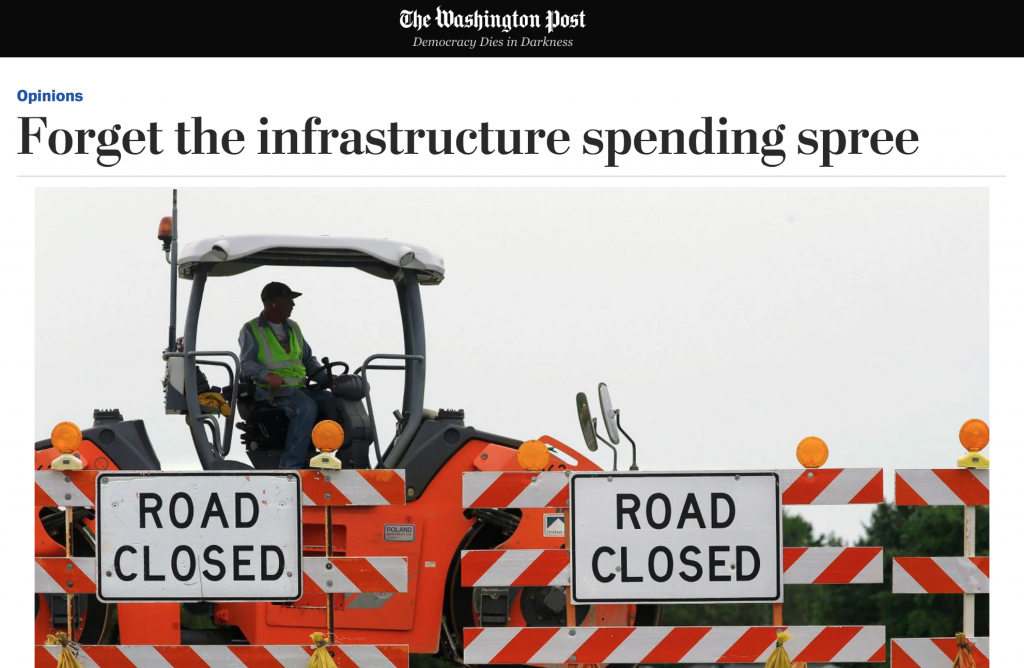REPAIR PRIORITIES 2019
Do our spending priorities line up with the perpetual rhetoric of ‘repairing our crumbling infrastructure?
 Between 2009 and 2017, the percentage of the roads nationwide in poor condition increased from 14 to 20 percent.
Between 2009 and 2017, the percentage of the roads nationwide in poor condition increased from 14 to 20 percent.
Policymakers continue to pay lip service to the notion of prioritizing repair and “fix-it-first,” yet we have little to show for all the rhetoric. The latest data in Repair Priorities shows that the conditions of our roadways have not improved, perpetuating a costly backlog of roads in poor condition. Congress provides states with billions in formula funding that they are free to use for maintenance. Yet, despite the backlog, states continue to spend a significant portion of funding to build new roads, creating costly new maintenance liabilities in the form of new roads and lane-miles.
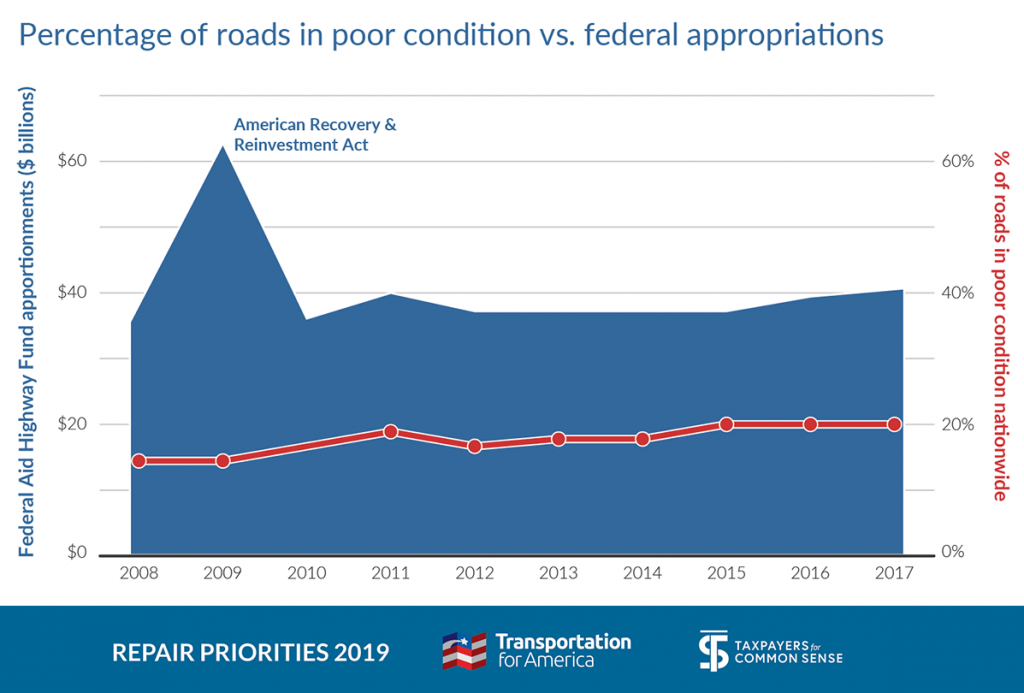
This is especially concerning given that Congress provided additional federal funding for transportation infrastructure twice over that time period. We also benefited from the one-time boost provided by the 2009 American Recovery and Reinvestment Act, which significantly increased the funding available for road repair for several years. Despite these injections of funds, states prioritized new or expanded roads and failed to make a dent in the backlog of roads in poor condition.
Repair Priorities 2019 was released by Transportation for America and Taxpayers for Common Sense in May 2019.
This is more than a money problem—it’s a priorities problem
The latest available data shows states have made some slight improvements in their spending since we released the first edition of Repair Priorities in 2011. Despite those improvements, states are still spending just as much on expansion as repair—states spent $21.4 billion on average on road repair annually and $21.3 billion annually on road expansion between 2009-2014.
These investments in expansion don’t just redirect funds away from much needed investments in repair; they continually grow our annual spending need, widening the gap. Every new lane-mile of road costs approximately $24,000 per year to preserve in a state of good repair. By expanding roads, we are borrowing against the future.
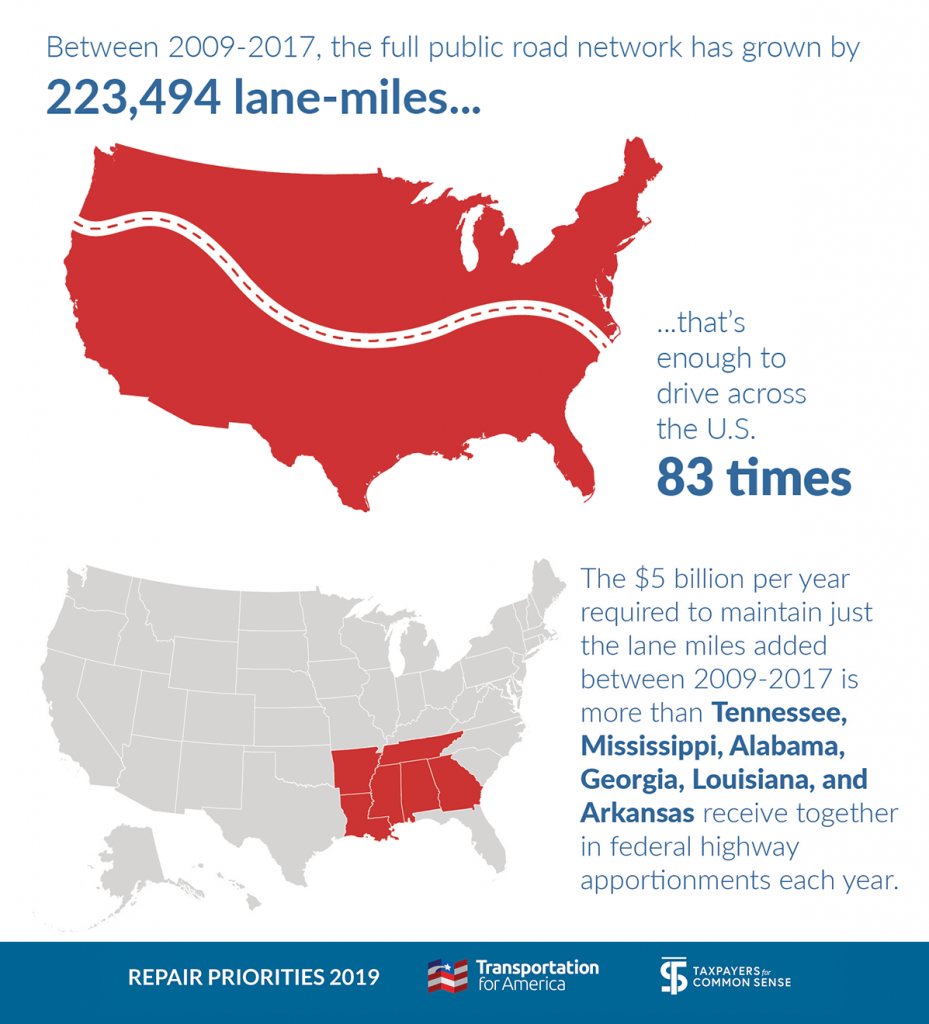
We face a looming spending gap
As of 2017, we estimate that we would need to spend $231.4 billion per year just to keep our existing road network in acceptable repair and bring the backlog of roads in poor condition into good repair over a six-year period. By comparison, all highway capital expenditures across all government units totaled $105.4 billion in 2015, only a portion of which goes to repair. It is significantly more expensive to rehabilitate roads that have fallen into poor repair than to preserve roads in good condition on an ongoing basis through routine pavement preservation.
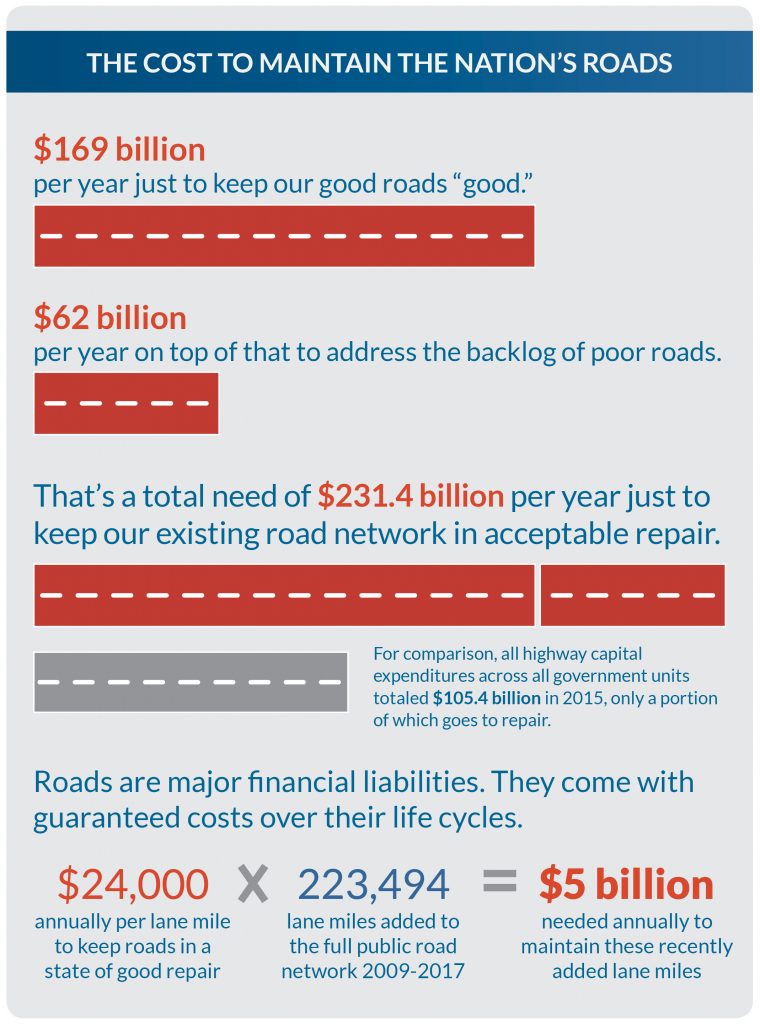
State spending priorities
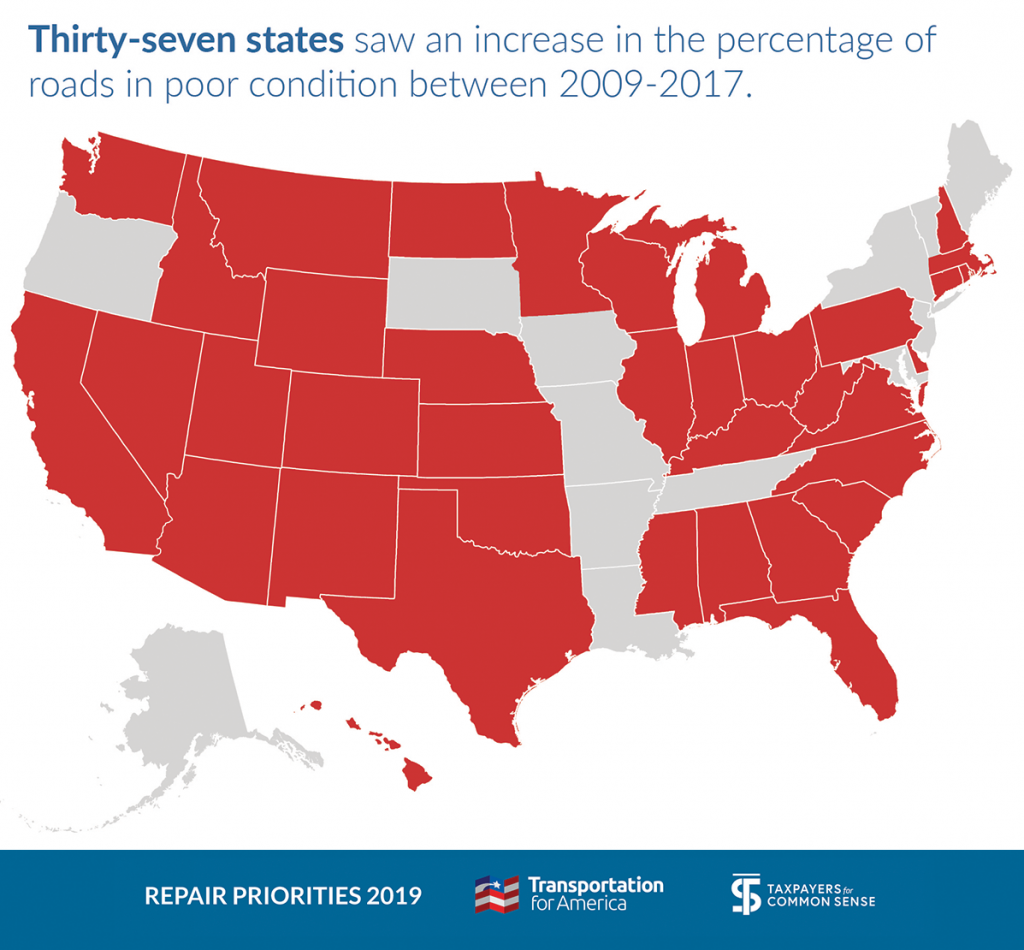
Some states are still spending to expand their road networks at the expense of their existing roads—an irresponsible use of taxpayer dollars. While pavement conditions worsened slightly at the national level between 2009-2017—even with billions in federal and state spending devoted to repair— the outlook is worse for many states, thirty-seven of which saw an increase in the percentage of roads in poor condition.
West Virginia, for example, devoted 31 percent of the state’s highway capital budget to road expansion between 2009 and 2014 and just 19 percent to road repair, and saw the percentage of roads in poor condition increase from 28 percent to 31 percent between 2009 and 2017. Yet on a state-by-state basis, the story is also more complex:
- Some states are spending a significant portion of their available funding on repair and are seeing pavement conditions improve over time—like New Jersey.
- Some states are devoting more of their available funds to road repair, but are still seeing worsening pavement conditions because the backlog is too great; for example, Michigan. These states may need additional funds to keep their roads in good condition.
- Other states, like Tennessee, have been able to maintain a large percentage of their roads in good condition with their available funding, allowing them to devote funds to road expansion without compromising the quality of their existing system.
Highway capital spending on state-managed roads, 2009-2014 (thousands)
| State | Annual avg. capital spending | Roadway expansion as % of total capital spending | Roadway repair as % of total capital spending | Other capital expenditures as % of total capital spending |
|---|---|---|---|---|
| Alabama | $1,054,459 | 28% | 41% | 31% |
| Alaska | $428,207 | 18% | 39% | 43% |
| Arizona | $1,189,547 | 52% | 15% | 33% |
| Arkansas | $907,555 | 45% | 19% | 36% |
| California | $3,910,413 | 16% | 35% | 49% |
| Colorado | $817,182 | 30% | 30% | 40% |
| Connecticut | $760,472 | 19% | 21% | 60% |
| Delaware | $324,368 | 36% | 19% | 45% |
| Florida | $4,527,857 | 26% | 37% | 37% |
| Georgia | $1,482,486 | 27% | 34% | 38% |
| Hawaii | $266,414 | 32% | 31% | 36% |
| Idaho | $461,386 | 19% | 36% | 45% |
| Illinois | $2,935,776 | 20% | 40% | 40% |
| Indiana | $1,919,996 | 49% | 20% | 31% |
| Iowa | $845,951 | 31% | 40% | 29% |
| Kansas | $1,012,787 | 34% | 33% | 33% |
| Kentucky | $1,439,153 | 36% | 30% | 34% |
| Louisiana | $1,775,066 | 29% | 22% | 49% |
| Maine* | $276,535 | 11% | 65% | 23% |
| Maryland | $1,335,539 | 25% | 20% | 56% |
| Massachusetts* | $1,050,132 | 4% | 23% | 74% |
| Michigan | $1,506,953 | 8% | 54% | 38% |
| Minnesota | $1,063,864 | 28% | 31% | 41% |
| Mississippi | $1,193,357 | 77% | 4% | 19% |
| Missouri | $1,466,900 | 31% | 20% | 49% |
| Montana | $466,541 | 21% | 45% | 35% |
| Nebraska | $529,745 | 5% | 53% | 42% |
| Nevada | $577,713 | 54% | 21% | 25% |
| New Hampshire* | $276,432 | 26% | 45% | 28% |
| New Jersey* | $2,476,888 | 7% | 57% | 35% |
| New Mexico | $482,148 | 19% | 39% | 42% |
| New York* | $3,794,065 | 7% | 43% | 50% |
| North Carolina | $2,420,087 | 55% | 11% | 34% |
| North Dakota | $523,825 | 10% | 68% | 23% |
| Ohio | $2,251,767 | 17% | 40% | 43% |
| Oklahoma | $1,166,559 | 33% | 27% | 40% |
| Oregon | $767,224 | 14% | 25% | 61% |
| Pennsylvania* | $3,873,959 | 29% | 22% | 48% |
| Rhode Island* | $240,421 | 3% | 20% | 77% |
| South Carolina | $767,133 | 24% | 32% | 44% |
| South Dakota | $367,747 | 12% | 69% | 19% |
| Tennessee | $1,484,522 | 36% | 16% | 47% |
| Texas | $7,259,320 | 48% | 15% | 38% |
| Utah* | $1,460,836 | 47% | 26% | 28% |
| Vermont | $222,675 | 10% | 46% | 44% |
| Virginia | $1,296,917 | 31% | 19% | 50% |
| Washington | $2,777,625 | 35% | 21% | 45% |
| West Virginia | $893,885 | 31% | 19% | 49% |
| Wisconsin* | $1,583,255 | 36% | 33% | 31% |
| Wyoming | $390,763 | 15% | 54% | 30% |
| Total | $72,304,409 | 29% | 30% | 41% |
*These states did not provide data to FHWA for at least one year of the analysis. Therefore, results may be skewed.
State road conditions
Thirty-seven states saw an increase in the percentage of roads in poor condition between 2009 and 2017. A number of states also saw their roads improve between 2009 and 2017. Arkansas, Kansas, Maryland, New Jersey, and Vermont saw the biggest decreases in the percentage of their roads in poor condition.
Eleven states have at least 30 percent of their road network in poor condition as of 2017. California, Connecticut, Hawaii, New Jersey, and Rhode Island had the highest percentage of roads in poor condition. These states are highlighted in red in the table below.
By contrast Georgia, Idaho, Nebraska, Oregon, and Tennessee had the lowest percentage of their roads in poor condition as of 2017. And Georgia, Maryland, Nebraska, North Dakota, Tennessee, and Wyoming had the highest percentage of roads in good condition as of 2017.
Percentage of public roads across jurisdictions in good, fair, and poor condition, 2017
| State | Public centerline miles of roads reported | % in poor condition | % in fair condition | % in good condition | % with unreported condition |
|---|---|---|---|---|---|
| Alabama | 24,814 | 14% | 33% | 53% | 0% |
| Alaska | 3,612 | 20% | 31% | 39% | 10% |
| Arizona | 12,260 | 19% | 38% | 41% | 2% |
| Arkansas** | 9,741 | 9% | 55% | 36% | 0% |
| California | 54,010 | 45% | 37% | 17% | 1% |
| Colorado | 16,560 | 22% | 44% | 32% | 2% |
| Connecticut | 6,335 | 34% | 44% | 21% | 0% |
| Delaware | 1,584 | 19% | 37% | 44% | 0% |
| Florida | 27,563 | 8% | 40% | 51% | 1% |
| Georgia** | 16,828 | 5% | 31% | 64% | 0% |
| Hawaii | 1,552 | 42% | 41% | 17% | 0% |
| Idaho | 9,751 | 5% | 50% | 43% | 1% |
| Illinois | 31,100 | 19% | 42% | 39% | 0% |
| Indiana** | 15,286 | 13% | 31% | 54% | 2% |
| Iowa** | 5,143 | 9% | 32% | 53% | 6% |
| Kansas | 24,344 | 10% | 46% | 44% | 0% |
| Kentucky | 12,878 | 10% | 44% | 45% | 1% |
| Louisiana | 13,267 | 25% | 38% | 35% | 1% |
| Maine | 6,169 | 22% | 36% | 41% | 0% |
| Maryland** | 2,917 | 11% | 23% | 66% | 0% |
| Massachusetts** | 5,324 | 30% | 41% | 29% | 1% |
| Michigan | 34,246 | 24% | 35% | 41% | 0% |
| Minnesota | 30,888 | 15% | 33% | 52% | 0% |
| Mississippi | 21,755 | 30% | 41% | 29% | 0% |
| Missouri | 30,075 | 23% | 45% | 32% | 0% |
| Montana | 12,538 | 11% | 34% | 54% | 0% |
| Nebraska | 16,252 | 7% | 28% | 64% | 1% |
| Nevada | 7,433 | 14% | 33% | 53% | 0% |
| New Hampshire | 3,550 | 25% | 30% | 44% | 0% |
| New Jersey | 10,893 | 34% | 44% | 22% | 0% |
| New Mexico | 11,867 | 31% | 37% | 32% | 0% |
| New York** | 16,803 | 19% | 33% | 46% | 2% |
| North Carolina | 21,499 | 13% | 44% | 42% | 1% |
| North Dakota | 12,197 | 10% | 26% | 64% | 0% |
| Ohio | 30,075 | 18% | 33% | 49% | 0% |
| Oklahoma | 30,235 | 33% | 38% | 29% | 0% |
| Oregon | 17,784 | 7% | 52% | 41% | 0% |
| Pennsylvania | 28,631 | 30% | 40% | 30% | 0% |
| Rhode Island | 1,761 | 53% | 36% | 11% | 0% |
| South Carolina | 21,094 | 18% | 46% | 35% | 0% |
| South Dakota | 14,969 | 14% | 46% | 40% | 0% |
| Tennessee** | 5,191 | 5% | 17% | 75% | 3% |
| Texas | 80,065 | 11% | 66% | 22% | 1% |
| Utah | 9,177 | 22% | 39% | 38% | 0% |
| Vermont | 3,758 | 17% | 33% | 49% | 0% |
| Virginia** | 12,752 | 10% | 44% | 45% | 1% |
| Washington | 20,162 | 29% | 45% | 25% | 0% |
| West Virginia | 10,487 | 31% | 43% | 25% | 0% |
| Wisconsin | 28,334 | 29% | 38% | 33% | 0% |
| Wyoming | 7,937 | 8% | 27% | 65% | 0% |
| U.S. Total | 853,446 | 20% | 41% | 38% | 1% |
** These states saw a major change in the number of miles reported in FHWA’s pavement condition tables for 2009 vs. 2017. This is likely due to inconsistencies in reporting practices and means 2017 results for these states may be skewed.
So what will it take to fix the system?
Transportation for America is calling on Congress to address this in any infrastructure package they consider, including the upcoming 2020 federal transportation bill. Congress should take the following actions in the 2020 transportation bill to get us back on track:
Guarantee measurable outcomes for American taxpayers with any new funding
The next transportation bill should set clear, quantifiable outcomes the program is expected to accomplish. Congress could set a goal for repairing all roads in poor condition and write a bill that clearly moves the ball forward toward that goal. If it cannot be done in the next six-year authorization bill, Congress should make clear what is feasible.
Require that states repair their existing systems before expanding
Congress should require that states dedicate available highway formula funding to repairing the existing system first. Historically, states have used this formula funding for new road construction. Congress could grant states additional flexibility if they are able to demonstrate that they are keeping their roads in good condition above a certain percentage threshold.
Require project sponsors to demonstrate that they can afford to maintain new roadway capacity projects
To supplement this formula funding now dedicated to repair and maintenance, Congress should create a competitive program to fund highway capacity expansion projects similar to the New Starts transit capital program. Projects should be evaluated for funding based on clear performance criteria to ensure that funded projects produce substantial benefit for the cost, and project sponsors should demonstrate that they can operate and maintain the asset throughout its useful life, ensuring a plan for long-term upkeep.
Track progress and require that FHWA publish results
The Moving Ahead for Progress in the 21st Century (MAP-21) Act in 2012 established a requirement that states and metro areas set performance targets for the pavement conditions of the interstate and non-interstate highways they maintain. Yet FHWA did not make those targets publicly available until spring 2019, seven years after passage of the law. The new transportation bill should establish stronger reporting requirements to ensure that our investments produce the needed results.
—
Hear about the findings
On May 15, we were joined by Taxpayers for Common Sense and two state DOTs—Massachusetts and Mississippi—to talk about the report and how some states are balancing funding for repair and expansion in their states. Watch the webinar >>
Forget the infrastructure plan
A pointed opinion piece in the Washington Post from T4America Director Beth Osborne makes the case that, in light of Repair Priorities showing how states neglect their repair needs in favor of costly road expansions, the long-discussed infrastructure plan to give them yet more money is a bad idea. Read the op-ed >>
Previous editions
Previous editions of this report were released by our colleagues at Smart Growth America with Taxpayers for Common Sense in 2011 and again in 2014.





